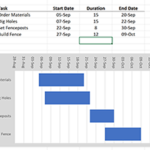
Believe it or not, gantt charts can be created relatively painlessly in Microsoft Excel. A simple one will take about 10 minutes with only a basic knowledge of Excel, and I'm going to show you how. Step 1: Enter the Task data The first step is to enter your tasks in table form in Excel. The following four pieces of data are the minimum requirement for a gantt chart, so … [Read more...]













